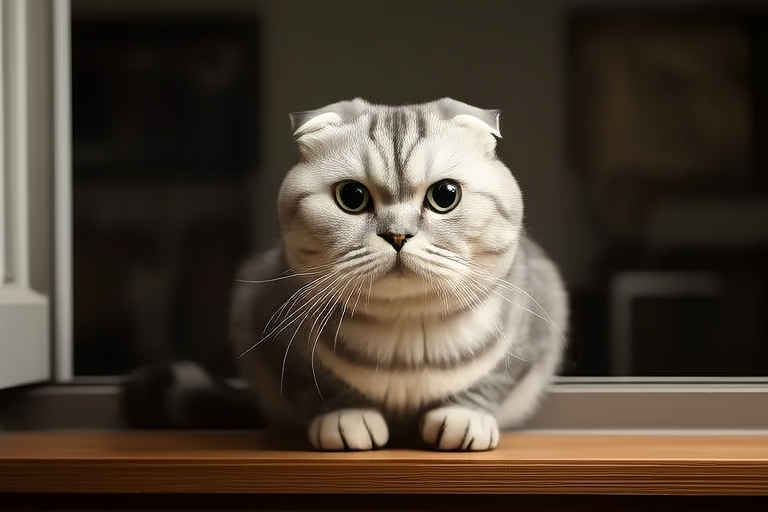Top 10 Fascinating Facts About the Unique Scottish Fold Cat
The Scottish Fold cat is one of the most distinctive breeds in the feline world, recognized for its unique physical attributes and endearing personality. This article delves into ten fascinating facts about the Scottish Fold that will captivate both seasoned cat enthusiasts and those considering adding this charming breed to their family.
1. The Origin Story: A Serendipitous Discovery
The history of the Scottish Fold begins in 1961, when a barn cat named Susie, with naturally folded ears, was discovered by William Ross in Scotland. Susie’s unusual ears were due to a genetic mutation, and she became the foundation for the breed. Ross, intrigued by her appearance, began breeding her to other local cats to develop the breed. The Scottish Fold’s name is a nod to its country of origin and its signature folded ears.
2. Distinctive Physical Features: The Folded Ears
One of the most striking features of the Scottish Fold is its folded ears, which are caused by a dominant gene known as the “folded ear gene.” These ears can be folded forward, sideways, or even backwards, creating a variety of adorable expressions. Not all kittens born to Scottish Fold parents inherit the fold, but those who do typically have a sweet, owl-like appearance. The folds usually become noticeable when the kitten is around three weeks old.
3. A Range of Coat Colors and Patterns
Scottish Folds come in a wide array of coat colors and patterns, making them visually diverse. From solid colors like black, white, and cream to more intricate patterns such as tabby, tortoiseshell, and calico, there’s a Scottish Fold to suit every taste. Their dense, plush coats also come in various lengths, from short to long, adding to their charm and uniqueness.
4. Temperament: Affectionate and Gentle
Scottish Folds are known for their gentle and affectionate nature. They are often described as being “dog-like” in their loyalty and desire for human companionship. These cats thrive on attention and enjoy being involved in family activities. They are patient and tolerant, making them excellent companions for families with children or other pets. However, they can also be independent and enjoy quiet moments alone, striking a balance between social interaction and solitude.
5. Health Considerations: Genetic Concerns
Despite their many positive traits, Scottish Folds face certain health challenges due to their unique genetic makeup. One of the most significant concerns is osteochondrodysplasia (OCD), a condition that affects bone development and can lead to joint problems. Responsible breeding practices are crucial to minimize the risk of these issues. Potential owners should seek out reputable breeders who prioritize the health and well-being of their cats.
6. Unique Behavior: Curiosity and Playfulness
Scottish Folds are known for their playful and curious nature. They love to explore their surroundings and engage in interactive play. Their intelligence and problem-solving skills make them adept at finding ways to entertain themselves. Many Scottish Folds enjoy playing fetch and can be trained to respond to simple commands, further endearing them to their owners. Their playful antics often involve batting at toys or chasing laser pointers, making them delightful companions.
7. Adaptability: Thriving in Various Environments
Scottish Folds are highly adaptable and can thrive in a variety of living situations, from bustling city apartments to spacious rural homes. Their calm and easygoing demeanor makes them well-suited to apartment living, where they can find contentment with limited space. In larger homes, they can enjoy exploring different rooms and outdoor areas under supervision. Regardless of the environment, they tend to form strong bonds with their human families, becoming cherished members of the household.
8. Historical Anecdote: Queen Elizabeth II’s Cats
One of the most intriguing stories surrounding the Scottish Fold breed involves Queen Elizabeth II of the United Kingdom. In the early 1970s, the queen expressed interest in acquiring a pair of Scottish Folds. However, due to strict quarantine laws at the time, she was unable to bring them to Buckingham Palace. Despite this setback, the queen remained a fan of the breed, and her interest helped raise awareness of the Scottish Fold’s unique qualities.
9. Longevity and Care: Lifespan and Maintenance
Scottish Folds typically live between 11 and 14 years, with proper care and attention contributing significantly to their longevity. Regular grooming is essential to maintain their thick coats, especially for long-haired varieties. Brushing several times a week helps prevent matting and keeps their fur soft and shiny. Additionally, providing a balanced diet, regular veterinary check-ups, and a safe, stimulating environment will ensure that your Scottish Fold enjoys a healthy and happy life.
10. Conservation Efforts: Preserving the Breed
To preserve the Scottish Fold breed while addressing health concerns, conservation efforts have been established. Organizations and responsible breeders work together to promote ethical breeding practices, ensuring that the cats remain healthy and true to their breed standards. These efforts include genetic testing, selective breeding, and education for potential owners. By supporting these initiatives, enthusiasts can help secure the future of this beloved breed.
In conclusion, the Scottish Fold cat is a breed rich in history, charm, and character. From their distinctive folded ears to their loving and playful personalities, these cats offer a unique experience for their owners. By understanding the breed’s origins, physical traits, temperament, and health considerations, potential owners can make informed decisions and provide the best possible care for their new furry friend. Whether you’re drawn to their quirky appearance or their gentle nature, the Scottish Fold is sure to captivate and delight you.
